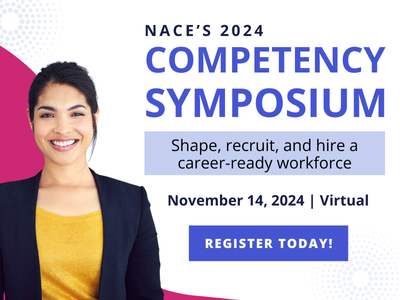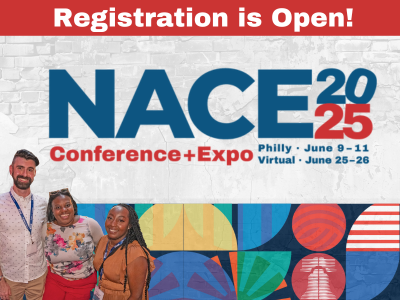Spotlight for Career Services Professionals
NACE Quick Poll: Virtual Career Fairs
NACE launched a quick poll on October 19, 2020, to gauge how virtual career fairs fared this fall. Results, which are being collected through late November, can be viewed in real time on the NACE website.Recently, Soulyka Agana-Woodbine, director of career development and preparation at Trinity Washington University, reported inviting all the employers in the school’s network to register for a career fair, with a goal of 50. However, only 10 registered.
She asked members of the NACE Community if their career centers have noticed a decrease in employer registration for virtual career fairs and what strategies might increase the number of employers attending.
Agana-Woodbine’s concern was echoed by other career center staff. While some offered suggestions for addressing the issue, others noted that students don’t seem as interested in attending.
Here’s what they said:
We've had a similar experience. We've decided to host industry-focused fairs this semester. That seems to be bringing the number of employers in for our social services/healthcare fair due to our population, but the other events (were not as) well attended by employers. I've found that a few employers are not sure what to do or how to use the system, despite all of the trainings, instructions, and video walk-throughs.
On the other hand, a lot of employers are hosting virtual information sessions. It might just be easier for them to host those types of events rather than participating in the fairs. Also, student participation has been stronger for the info sessions than for the fairs.
While the setup for the fairs may have been a bit overwhelming, once the fairs got underway, both students and employers found the experience easier than they expected and they were able to make meaningful connections. Continuous follow up with employers and helping them throughout the process really helps. The video walk-throughs make the virtual career fair experience more tangible for employers too.
Keith Okrosy, student career programs manager, Hunter College
The combination of Zoom fatigue coupled with the inherent challenges of virtual events has created a downward spiral causing fewer employers to attend, causing fewer students to attend, causing even fewer employers to join. My suggestion is to stop thinking about career fair participation as the goal, but rather focus on other ways to help your students and employers engage. We've seen two in particular be really effective this year: experiential recruiting opportunities and speed networking events. In both cases, participation by employers and students has been incredible as there is real value created for both.
During a survey this summer, almost half the college seniors reported they were not planning to attend virtual career fairs. And, while not as scientific as the survey, we've informally heard from students that the number is much, much lower. When digging in further, we've found that the students are not using these sessions to explore (which is the primary benefit for employers), but rather to express interest to those companies where they are already planning to apply.
Beyond the surveys, having done a bunch of guest lectures and other events with students (tied to my roles on the boards or advisory councils of some colleges), and the responses from students shows the engagement numbers are worse than the survey projected. Not scientific, but interesting.
Specifically, the percentage of students showing up to the events seems to be below 50%, but I do expect that will increase over time. However, the more interesting aspect is the average number of companies with which the students engaged at the virtual career fairs or info sessions seems to be under three.
Students have shared that they are either showing up “for the face time at companies where [they] are already planning to apply,” and/or they go to a couple and realize (in their words) “they're useless.” Some other terms that came up were “nothing new,” “same as the website,” and “scripted.”
On the company side, many have shared that the numbers are way down as well. However, even those who are seeing strong attendance have been disappointed with the lack of diversity of the students as “they reflect the backgrounds of our current employees.” While the ad hoc engagement from on-site events help overcome the lack of social capital that challenges many students from underrepresented background, the structure of remote events make this much more difficult.
Jeffrey Moss, founder and CEO, Parker Dewey
I work at Randolph-Macon College—a small, liberal arts college with less than 2,000 students. We successfully ran our first virtual career fair powered via Zoom in late April and have since run two industry-specific career fairs in September with another one coming up at the end of this month. I'm not sure what (a CMS) offers in the way of functionality for career fairs, but I don't believe there is a video/visual component to allow employers and students to interact face-to-face. This is ultimately why we made the decision to go with Zoom. Also, since we don't have the budget to purchase a virtual career fair platform, we've passed along the savings of using our free Zoom account to the employers by offering our fairs at no cost.
I think smaller, industry-specific career fairs are the way to go. My suggestion is to focus on quality, not quantity. Identify the employers that have successfully hired your graduates and interns and reach out to them via phone. We have intentionally kept our career fairs under 20 employers since any more would be difficult to manage via Zoom. And so far, it's worked out.
I agree that some employers are also opting to go the info session route. Ultimately, whether a student attends a career fair, info session, or a virtual networking event, the important thing is that they are making those connections that will hopefully help them land a job or internship.
Jessica Majkowycz, assistant director, employer relationships and internships, Randolph-Macon College
It seems that students are considering virtual events as more transactional in nature, rather than offering the relationship-building opportunities of “IRL” career fairs. This, in turn, impacts interest in investing time in digital interaction.
I do find it interesting that employers are pushing back about the amount of time needed to prepare for and participate in virtual events; hasn't that been promoted as a significant advantage in not having to travel to campus?
Mary Scott, managing consultant, Scott Resource Group
Los Medanos College is a community college with a headcount around 8,700. We attempted our first virtual career fairs this July via Zoom and were reasonably happy with the results. Both fairs were industry specific and we selected Zoom as a platform specifically because it is already familiar to both students and employers. Each fair had about a dozen employers, all of whom had previously told us they were actively hiring about 30 students; these numbers are about half of our annual in-person fairs. In a Zoom environment, we estimate capacity at around 60 students, at least the way we ran it. We believe that reaching out to employers ahead of time to query their level of interest and hiring plans helped with commitment to attending.
One factor to consider when setting a target number of employers is considering the realistic number of students you expect to draw. We faced the challenge that some employers saw only one or two students, which makes it hard for an employer to justify spending two hours on an event. With in-person fairs, there is a greater likelihood of spontaneous traffic at an employer's table based on their display, swag, and pitch (“Come over here!”) than with a virtual fair; we had to actively promote several lesser-known employers and push students to them while they waited for a popular employer's breakout room to be less full. Everyone wants to go talk to Google and Kaiser, but they rarely click into Acme Systems that they've never heard of.
Bill Bankhead, manager workforce and economic development, Los Medanos College
From what I've heard from career services, employers, and the 20 or so most highly regarded virtual career event companies, the employers absolutely are being reminded that a virtual career event takes far less of their time than an in-person event.
My takeaway is that the employers are being rational. We all have a limited amount of resources, whether that's budget or time. We need to make the best use of those resources. To do that, we need to look at our returns on investment. We sometimes do that with the use of some math and other times just intuitively. The basic calculation they're all making is to consider the return they're getting from their investments of money and time. Even if the investment of time is a lot lower to attend a virtual than in-person career investment, if the return is so low as to be unmeasurable, then no rational talent acquisition professional is going to want to make that investment again, regardless of how low it is.
What we're seeing over and over again is that virtual career events are well-designed to engage candidates who already are aware of your brand and interested in your opportunities. Some of them have not yet applied and want questions answered before they decide to do so. Others have applied and want more interaction. But if they're not already aware of your brand and interested in your opportunities, then virtual career events are not a suitable product. You first need to reach the candidate, meaning making them aware of your brand and opportunities. You then move to engagement.
Steven Rothberg, president and founder, College Recruiter
Remember a few years ago (maybe I'm aging myself) when there was a lot of chatter about career fairs being dead? Then came the rise of “boutique” events... then we saw a fierce return of the traditional “all purpose” fair... and so we all went on our merry ways doing what best suited our campus and our employers, but (I suspect) most of us continued with the big-top event? And then COVID hit and we were forced to look at new options. In the six months since, we’ve had to jump differently; I think many of us are seeing that the time has come to give up the big-top event. Our students (speaking from a traditional, small, residential, private institution perspective) crave more individualized experiences. And I think our employers prefer to have access to students that feels more personalized and focused rather than the five minutes of interaction they may get standing at a table in a gym full of other employers doing the same thing, all competing for attention.
We're considering walking away from any big-top fair and setting up a series of info sessions for employers. Employers select their date/time that works best (we'll provide guidance on that), and we market the session directly to students who are mostly like to be interested and/or who employers want to see. Then we'll facilitate an interview day for the employer. We may go with “theme” weeks—for example, tech and science firms will have info sessions on week four; non-profits and human services on week five, etc. Regardless of how we do it, we'll be virtual. This fall, our students are reporting good comfort with virtual experiences—even acknowledging that they know in-person is better, but this is the world right now. And we’ve found our faculty are more likely to encourage participation in our events, which usually are no more than one-hour duration, especially when scheduled away from the high-class count time of day (less competition). Virtual fairs are certainly more time-use efficient than eating up a four-hour block of time on campus. I, for one, am glad that the virtual fair is more commonplace—no more dealing with reservations, table assignments, catering, parking, shuttles, etc. I suspect employers will like the theme week info session model, too—no more travel to campus and they can still have a meaningful conversation with students, albeit video-based.
The ad-hoc element is where I think we have to mine the gold and get innovative. As we continue to play with this idea, we expect to build specific messaging to students about how their academic knowledge translates to the NACE 8 (career readiness competencies), which is what employers want to see. We have to connect the dots for students and get them thinking away from “my major is my destiny.” For example, a bio student may not see the relevance of those skills into working for a business services company, but in fact, bio majors have prodigious critical thinking, problem solving, and teamwork skills—all of which translate into doing analytical and strategic planning.
Dr. Julia Overton-Healy, director, Career Services Center for Career & Academic Planning, St. John Fisher College
We are hosting one to two employer (with current or anticipated openings) virtual information and recruiting sessions of various industries this semester to give us time to gauge the success rates and environment of virtual fairs. We are seeing low employer engagement and even lower student attendance (average two/session). This experience has me questioning whether to host industry-specific career fairs in the spring. I am struggling to create meaningful experiences/events for our students and employer partners, and I worry the low student headcount will ruin employer partnerships and impact the reputation of our students and university.
Taylor Van Antwerp, director of career services, University of Bridgeport
Even though the majority of our students—approximately 1,200 out of 2,000—are liberal arts majors, we also have students in our other schools: business and graduate studies, nursing and health professions, education and continuing education programs. I'm wondering if employers are reading our school bio and grouping us automatically in the “liberal arts” category.
I wonder why students aren't signing up, besides Zoom burn out. Could it be that they don't understand how the virtual career fair format will work? Some of the ideas I had once student registration for the career fair goes live later this month are:
- Asking a student to create a brief video about why they are planning to attend the virtual career fair. Highlighting some key benefits.
- Asking faculty partners to share the video and career fair promo in their classes.
- Attending our weekly Campus Conversations via Zoom (hosted by our university president) to promote the virtual career fair and answer student/staff/faculty questions.
Soulyka Agana-Woodbine, director of Career Development and Preparation, Trinity Washington University
If you have ideas for increasing interest in virtual career fairs—or if you’re finding information sessions or other activities are working well for students, employers, and career centers—join the conversation in the NACE Community.






